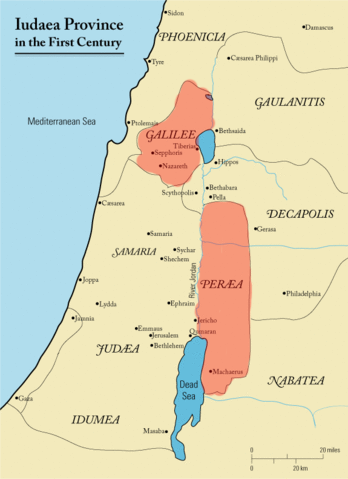Herod Antipas was the son of Herod the Great and younger brother of Archelaus (both by Malthrace). Jesus was born during the reign of Herod the Great. Herod the Great's initial political career was as the the governor of Galilee, and later he was appointed as king over Judea by Caesar Octavius (Augustus). After he died, there was some conflict as to which of his sons were to become king of Judea (ultimately, none of them became king over all of Judea as he was). Herod made an amendment to his will just days before his death indicating that Archelaus should be king, but it didn't play out that way.1
Herod had written six wills during the course of his life. The sixth will was actually a codicil of his fifth will. Since this final version had been written only five days before his death, it had not been ratified by the emperor. Therefore, although Archelaus took over the leadership at Herod’s death he did not use the title king (Antiq. 17.8.4 §§202–3; War 2.1.1 §§2–3). After the Passover he and Antipas set out for Rome to dispute the last two wills, leaving Philip behind to govern. Archelaus wanted to convince Augustus that he should ratify the will made just before Herod died, because it represented his wish. On the other hand, Antipas sought to convince the emperor that Herod had not been of sound mind and body when he wrote the last will. While they were in Rome there was a revolt in Palestine, and a Jewish delegation arrived in Rome to ask autonomy for the nation and for union with the province of Syria. After much debate Augustus devised a compromise. He made Archelaus ethnarch (meaning “ruler of a nation”) over Idumaea, Judea, and Samaria. He made Antipas tetrarch (meaning “ruler of a quarter”) of Galilee and Perea and Philip tetrarch over Gaulanitis, Trachonitis, Batanea, and Paneas (Antiq. 17.11.4 §§317–20; War 2.6.3 §§93–100). Thus, Antipas, while losing his bid to be king, did prevent Archelaus from ruling the entire nation.2
So to clearly answer the question, Herod Antipas was "ruler of a quarter" (tetrarch) over Galilee and Perea. I've highlighted these regions in red/pink in the map below.
 3
3
1 Walter A. Elwell and Barry J. Beitzel, Baker Encyclopedia of the Bible (Grand Rapids, MI: Baker Book House, 1988), 967-8.
2 Ibid., 968. I linked all of the primary sources cited in the Encyclopedia to the English translations of the works available for free on the Christian Classics Ethereal Library so that you can read them for yourself.
3 Map from https://en.wikipedia.org/wiki/Perea#/media/File:First_century_Iudaea_province.gif (edited to highlight Galilee and Perea).

